Clinico-pathological Characteristics and Survival Analysis of 300 Thyroid Cancer Cases in One Referral Hospital in Kelantan, Malaysia: A 10-year study
Download
Abstract
Introduction: Thyroid cancer is ranked fourth in a state of Kelantan, while ranked much lower in other states in Malaysia. We determined the clinicopathological characteristics and the survival analysis of each thyroid cancer type seen in Hospital Universiti Sains Malaysia (HUSM), a referral hospital in the East Coast region of West Malaysia.
Methods: Registry of patients diagnosed with thyroid cancer from years 2006 to 2015 was obtained from the medical record office of HUSM. Close scrutiny of the registry was carried out manually to ensure no duplicate entry. The data obtained were age, gender, histological diagnoses and dates of clinical follow-ups. The data were analyzed using IBM SPSS statistics version 24 for Windows. Survival analyses were carried out using Kaplan Meier approach.
Results: A total of 300 patients with thyroid cancer were recorded in this 10 year period. The average rise of cancer per year was 27.2%. The most common tumor type was papillary; 230(76.7%) followed by 58(19.3%) follicular, 10(3.3%) anaplastic and 2(0.7%) medullary carcinomas. Female to male ratio was 4.1:1 (p=000). All anaplastic carcinoma cases were women. The age ranged from 11 years to 86 years with the mean age for women at 49.78 years (SD15.17) and for men at 53.27 years (SD14.45). The peak age for papillary carcinoma was in the 5th decade. The 5-year survival of papillary was 94%, follicular 88% and anaplastic 30% and the two medullary carcinoma cases are still alive after 5 years. In general, women had higher survival than men for papillary and follicular carcinoma. Those below 40 years old had the better prognosis compared to older patients.
Conclusion: The frequency of thyroid cancer in Kelantan is increasing over the years. The peak age of the patients is older than those thyroid cancers associated with radiation exposure. The 5-year survival for all cancers is comparable with other countries.
Introduction
Among all cancer types, one of the fastest growing types in the world is thyroid cancer [1]. Malaysia has 14 states of which seven of these states namely Sabah [2, 3],Sarawak [4, 5], Kelantan [6], Terengganu, Pahang, Perlis, and Kedah are noted to have the high incidence of goiter [7]. Thyroid specimens surgically removed for multi-nodular goiter at Hospital Universiti Sains Malaysia (HUSM) showed 34-60% of them had malignant transformation; a high figure compared to the international incidence of 4 to 17%[8]. In Kelantan 31.4% of the populations of the coastal/low land areas and 45.0% in the inland areas had goiters. In HUSM, nodular hyperplasia [histological diagnosis of goiter] was seen in 72.0% of 1486 thyroid specimens received in Pathology laboratory [8].
One of the complications of long-standing goiters is thyroid cancer. Cancer registries of Malaysia in 2002, 2006 and 2007 recorded thyroid cancer as the 6th to 11th most common cancer in women with Age-Standardized Rate (ASR) from 2.6 to 4.9. Thyroid cancer is high in a community which has goiter prevalence [9]. Thyroid cancer is the 4th common cancer in Kelantan state with ASR of 5.1, higher than the national average [9]. In the non-endemic state of Pulau Pinang, thyroid cancer is not listed as one of the top 10 cancers while in the endemic states of Sabah and Kelantan, thyroid cancer is the top 5 cancers [9].
The most common thyroid cancer seen in Malaysia and elsewhere is papillary carcinoma (PTC) [10, 11]. Often patients come in advanced stage making surgery problematic [12]. The Malays[10] and the Ibans [11] have a higher predilection to have thyroid cancer compared to other races. Females have the cumulative risk of three to four times more than males and the peak age is 35-45 years. In other countries, PTC incidence is also high in countries which are endemic with iodine deficiency [13-15].
This study is to evaluate the trend of incidence of thyroid cancer in Kelantan over a ten year period between 2006 to 2015 and map them against the geographic location of these patients. The previous study on iodine deficiency in Kelantan[6] showed that those living inlands/highlands had the higher prevalence of iodine deficiency. We wanted to investigate whether iodine deficiency is a risk factor for thyroid malignancy. Kelantan is made up 4 coastal districts namely Bachok, Kota Bharu, Pasir Puteh, and Tumpat and 5 inland/highland districts; Pasir Mas, Jeli, Gua Musang, Kuala Kerai, and Macang. Being a referral centre, all cases of thyroid cancers seen in other hospitals in Kelantan and adjacent states are referred to HUSM for further management. We also analysed the survival of the patients according to tumour types.
Materials and Methods
The registry of patients diagnosed histologically as thyroid cancer from the year 2006 to 2015 was retrieved from the medical record office of Hospital Universiti Sains Malaysia (HUSM). From these data, the variables extracted for each year were age, gender, residential addresses (classified under the nine districts of Kelantan and under ‘Others’ if the patients were from outside Kelantan), the tumour types and the current status (alive or dead) of the patients. The data were scrutinized to ensure no repeat entry in the same case. These data were analyzed using IBM SPSS statistics software version 24 for Windows. The level of significance was set at p<0.05. The survival analyses were carried out using Kaplan Meier approach. Survival was estimated by sex, age, and duration of illness for each of the tumour type.
Results
General Results
A total of 300 thyroid cancers were recorded from 2006 to 2015, the trend of thyroid cancer over this ten-year period showed that the incidence remains low in the first few years but increased rapidly from 2010 onwards (Fig.1). The average rise of cancer per year is 27.2% Throughout this period, 241/300(80.3%), were women and 59/300 (19.7%) were men. Female to male ratio was 4.1:1 (p=000). The mean age for women was 49.78 years (SD15.17) while for men was older at 53.27 years (SD14.45).
Figure 1 The prevalence of thyroid cancers from 2006 to 2015 in Hospital Universiti Sains Malaysia
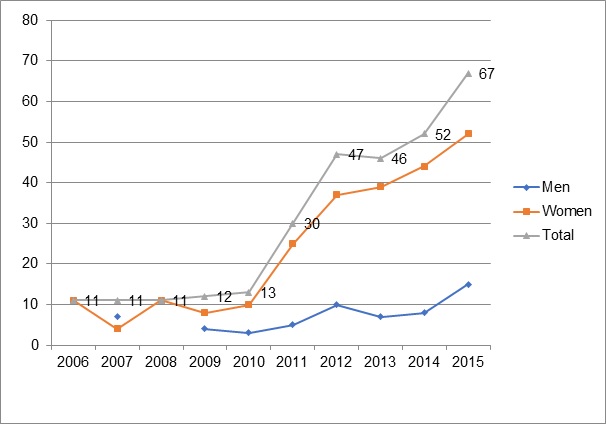
Tumor Type
Papillary carcinoma was the commonest tumor type for all years (Fig. 2). The breakup by gender and the tumour type is in Tabl 1. All patients who had anaplastic carcinoma were women. Majority of the patients with papillary carcinoma; 182/230 (79.1%) and follicular carcinoma; 48/58 (82.8%) were women. The peak age was at the 5th decade (Fig. 3). The youngest patient was 11 years old and the oldest, 86 years of age and both had papillary carcinoma. Those patients with anaplastic carcinoma were older than 50 years. There were two cases of medullary carcinoma one each per gender.
Figure 2 :The number of Thyroid Cancer cases Compared by Tumor Type in Hospital Universiti Sains Malaysia, 2006-2015
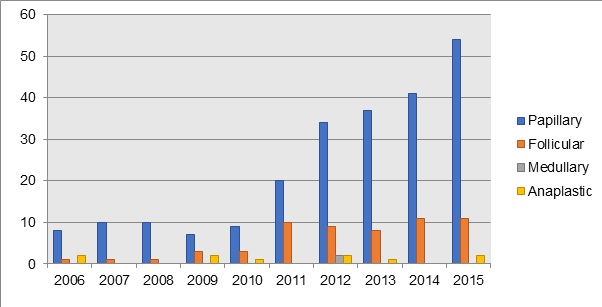
| Men | Women | Total | |||||
| Frequency | %a | Frequency | %a | ||||
| Papillary | 48 | 20.87 | 182 | 79.13 | 230 | ||
| Follicular | 10 | 17.24 | 48 | 82.76 | 58 | ||
| Medullary | 1 | 50.00 | 1 | 50.00 | 2 | ||
| Anaplastic | - | - | 10 | 100.00 | 10 |
a) a Percentage of row total
Figure 3 : Frequency of Thyroid Cancer Cases for each tumour type by Age Group in Hospital Universiti Sains Malaysia, 2006-2015.
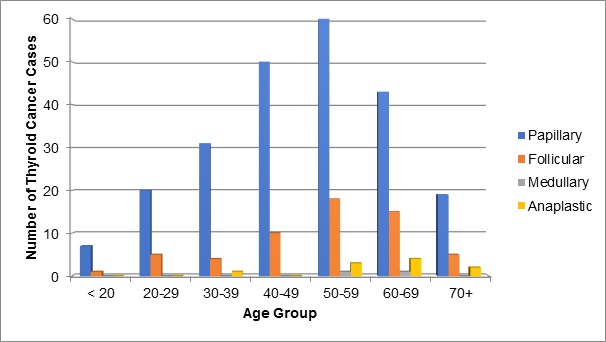
Geographical location of patients based on tumour type
When the patients were mapped against their residential addresses, the majority of patients were from the Kota Bharu District (p=000). Fig. 4 demonstrates the location of these patients according to the tumour types. The 2 medullary cancers were from outside Kelantan state.
Figure 4 : The thyroid cancer patients’ residential addresses according to districts and tumour types in Kelantan
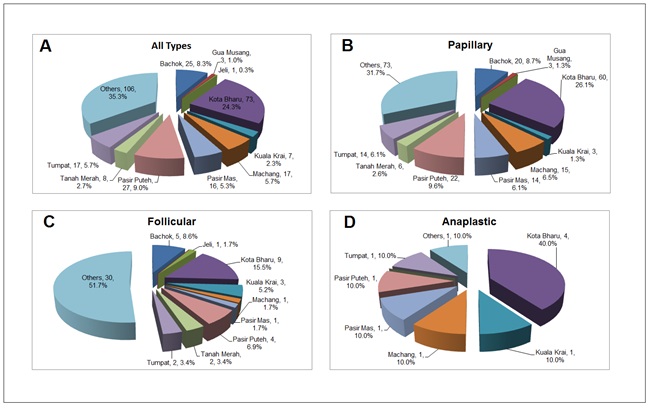
Survival Analysis
Over the ten year period, seven of the anaplastic carcinoma patients have died. The break-up of the number of deaths per each tumour type is shown in Tabl 2. The survival at one year and 5th year is as shown in Tabl 3. Survival is best for papillary carcinoma and worst for anaplastic carcinoma. In general, those below 40 years old had better survival compared to older patients. For all three types of cancer, the survival at 1-year was 90% and 88% at 5-years. Women had higher survival than men for all cancers. The survival decreased with age for all tumor types. The details of the number of alive and dead patients over this ten years are shown in Tabl 2 and the 1-year and 5-year survival rates in Tabl 3. The Kaplan Meier curves for each tumour type (except Medullary carcinoma) are shown in Fig. 5.6.7. To the time of writing the two cases of medullary carcinoma patients are still alive beyond 5 years.
| Alive | Death | Total | ||||
| Men a | Women a | Men a | Women a | |||
| Papillary | 44 (83.02) | 172 (77.83) | 4 (66.67) | 10 (50.00) | 230 | |
| Follicular | 8 (15.09) | 45 (20.36) | 2 (33.33) | 3 (15.00) | 58 | |
| Medullary | 1 (1.89) | 1 (0.45) | - | - | 2 | |
| Anaplastic | - | 3 (1.36) | - | 7 (35.00) | 10 |
a) a Frequency (%): percentage of row total
| 1-year Survival | 5-year Survival | |
| Papillary | ||
| Men | 90% | 88% |
| Women | 92% | 90% |
| <40 | 100% | 100% |
| 40+ | 90% | 89% |
| Overall | 94% | 90% |
| Follicular | ||
| Men | 100% | 66% |
| Women | 90% | 90% |
| <40 | 100% | 100% |
| 40+ | 90% | 84% |
| Overall | 94% | 88% |
| Anaplastic | ||
| Men | - | - |
| Women | 30% | 30% |
| < 40 | 100% | 100% |
| 40+ | 21% | 21% |
| Overall | 30% | 30% |
Figure 5 :Survival Analysis for Papillary Thyroid Carcinoma by Gender
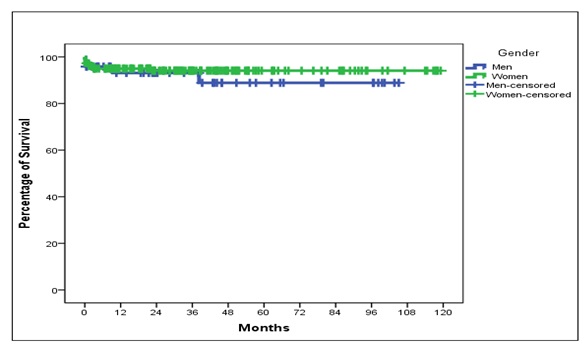
Figure 6 :Survival Analysis for Follicular Carcinoma of Thyroid by Gender
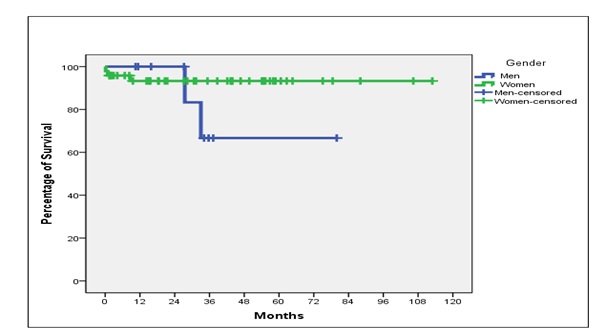
Figure 7 :Survival Analysis for Anaplastic Carcinoma by Gender [all cases of anaplastic carcinoma were females].
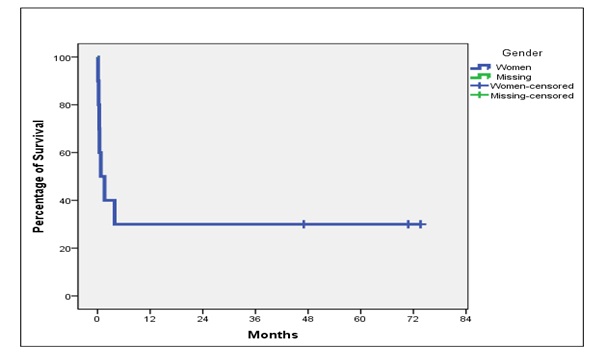
Discussion
This study highlights few findings; thyroid cancer showed a rising trend in Kelantan from 2006 to 2015 at an annual rate of about 2.7%. Women were four times more at risk than men; the peak age was in the fifth decade, older than those seen in countries affected by radiation exposure. Majority of patients were from the Kota Bharu District and the one and five years survival rates per each tumour type were comparable with data worldwide.
Thyroid cancer incidence is rising globally for the last few decades while the mortality is declining[16]. For example, in Shanghai, there were increasing cases of thyroid cancer from 34 to 137 in men and from 102 to 536 in women between 1983 and 2007 [17]. From our study we notice the trend of thyroid cancer in Kelantan is also increasing rapidly from 11 cases in 2006 to 67 cases in the year 2015 for all tumor types, resembling those seen in Shanghai and France[18]. This increase concerned exclusively for papillary carcinoma. In the literature during 60’s to 80’s, thyroid cancer was more common in the younger age group. However, in our study, it was found to be more common in the fourth and fifth decades, similar to what is observed in the United States[19]. Improvement in clinical practice and more refined diagnostic techniques in HUSM are also contributing to the increase in the number of cases seen over the years[20]. This is also true elsewhere [18],[21]. Other explanations, including environmental influences, is one of the possible factors contributing to the increase in incidence [22].
Known factors of thyroid carcinomas are radiation exposure[23], genetics[24, 25], obesity[26] and iodine deficienc y[27-29]. Kelantan population has been observed to have chronic iodine deficiency [30]. Animal experiments have shown an increasing incidence of thyroid carcinomas after prolonged iodine deficiency [31]. Chronic Multi-Nodular Goitre (MNG) has a been associated with thyroid cancer especially papillary carcinoma [32 33, ]. In cancers associated with iodine deficiency, papillary thyroid carcinomas are more than other cancers supporting the results of our study where papillary cancer is the most common. Interestingly, we observed the districts near coastlines (Bachok, Kota Bharu, Pasir Puteh, and Tumpat) had the higher frequency of thyroid cancers than those districts located far inland. We would have expected that the people living near coastlines to be less iodine-deficient than the folks who live inland. A previous study was done on goitrous patients in Kelantan, 22.7% MNG or nodular hyperplasia expressed RET protein, the protein known to be involved in thyroid cancer [34]. The cause of MNG is chronic iodine deficiency. Ret gene mutation is associated with thyroid cancer [35].
Malaysian women are given iodized salt supplementation only during pregnancy when they attend antenatal checkup in hospitals. Provision of iodine may need to be extended lifelong. Countries which have introduced effective iodine supplementation in their diet have shown a reduction in papillary cancer[18]. Iodine deficiency alone is not the only risk factor[36]. The main risk factor remains exposure to nuclear radiation. However, there is no known radioactive fallout in Kelantan state nor elsewhere in Malaysia unlike those living in nuclear fall-outs such as Hiroshima, Nagasaki, Fukushima, and Chernobyl or other regions. What then could we attribute the reasons why thyroid cancer is high in Kelantan? Could we postulate people living in Kelantan coastline are more at risk as they are nearest to Japan? Could this also be the reason why Kelantan, Terengganu, Sarawak, and Sabah are the states in Malaysia that have the high incidence of thyroid cancers? Further studies are needed to answer this.
The mean age of patients in our study is 49.78 years for women 53.27 for men, much older than those reported in other countries[37] probably confirms earlier findings that long-standing goiter may complicate cancer development. The thyroid glands of these patients may have started to enlarge during childhood. The age of patients with papillary carcinomas seen in patients who are exposed to radiation is younger while those due to chronic iodine deficiency is older as seen in this study.
Our study shows that the overall survival of thyroid cancer is comparable with other studies[38 39, ]. In our study, survival from papillary and follicular carcinomas was higher in women similar to what was found in France [18]. Others have not found that gender influence survival differences [15]. Our study observed that those below 40 years old had better survival than older patients, finding similarly noted by other researchers [40].
Studies have shown iodized salt supplementation has reduced goiter prevalence[41] thus reduces the risk of cancer development [18 19, ]. Supplementation leads to an increase in the ratio of differentiated to undifferentiated carcinoma [42]. The prognosis and survival of differentiated thyroid cancer have also improved after iodized salt supplementation [42].
In Conclusion, The trend of thyroid cancer in Kelantan is increasing over the ten-year period from 2006 to 2015. It has a female preponderance. The mean age is 49.78 years for women 53.27 for men, several years older than those thyroid cancers associated with radiation exposure. Since Kelantan is not known to have radioactive exposure, the cause of thyroid cancer in this population is probably secondary to prolonged iodine deficiency. The five-year survival for differentiated thyroid cancer is above 90%, comparable with most published studies.
Acknowledgments
The authors would like to thank Dr. Noor Hashimah Abdullah for her invaluable help in data analysis using SPSS and Madam Zati Iwani, academic supervisor for the second author who is a final year undergraduate doing industrial training at Health Campus Universiti Sains Malaysia.
References
[1]. Jung K-W, Won Y-J, Kong H-J, Oh C-M, Cho H, Lee DH, Lee KH: Cancer statistics in Korea: incidence, mortality, survival, and prevalence in 2012. Cancer Research and Treatment. 2015;47(2):127-141.
[2]. Chen PC, Wong ML, Ong FP: The prevalence of endemic goiter in the Keningau Division of Sabah. Asia Pac J Public Health. 1989;3(1):78-81.
[3]. Chen PC, Yap SB: The prevalence of endemic goiter among Penans of the Baram. Med J Malaysia. 1988;3(2):159-161.
[4]. Chen PC, Lim PP: The prevalence of endemic goiter in the Tinjar area, Sarawak. Med J Malaysia. 1982;37(3):265-269.
[5]. Ogihara T, Oki K, Iida Y, Hayashi S: Endemic goiter in Sarawak, Borneo Island; prevalence and pathogenesis. Endocrinol Jpn. 1972;19(3):285-293.
[6]. Mafauzy M, Wan Mohamad WB, Yasmin Anum MY, Musalmah M, Mustafa BE: The prevalence of endemic goiter in Kelantan, Malaysia. Med J Malaysia. 1993;48(1):64-70.
[7]. Selamat R, Mohamud WN, Zainuddin AA, Rahim NS, Ghaffar SA, Aris T: Iodine deficiency status and iodised salt consumption in Malaysia: findings from a national iodine deficiency disorders survey. Asia Pacific journal of clinical nutrition. 2010;19(4):578-585.
[8]. Othman NH, Omar E, Naing NN: Spectrum of thyroid lesions in Hospital Universiti Sains Malaysia over 11years and a review of thyroid cancers in Malaysia. Asian Pac J Cancer Prev. 2009;10(1):87-90.
[9]. Othman NH, Nor ZM, Biswal BM: Is Kelantan joining the global cancer epidemic?--experience from Hospital Universiti Sains Malaysia; 1987-2007. Asian Pac J Cancer Prev. 2008;9(3):473-478.
[10]. Abdullah M: Thyroid cancer: The Kuala Lumpur experience. ANZ J Surg 2002, 72(9):660-664.
[11]. Htwe TT, Hamdi MM, Swethadri GK, Wong JO, Soe MM, Abdullah MS: Incidence of thyroid malignancy among goitrous thyroid lesions from the Sarawak General Hospital 2000-2004. Singapore Med J. 2009;50(7):724-728.
[12]. Harjit KD, Hisham AN: Large fungating thyroid cancers: a unique surgical challenge. Asian J Surg. 2005;28(1):48-51.
[13]. Huszno B, Szybinski Z, Przybylik-Mazurek E, Stachura J, Trofimiuk M, Buziak-Bereza M, Golkowski F, Pantoflinski J: Influence of iodine deficiency and iodine prophylaxis on thyroid cancer histotypes and incidence in endemic goiter area. J Endocrinol Invest. 2003;26(2):71-76.
[14]. Szybinski Z, Huszno B, Zemla B, Bandurska-Stankiewicz E, Przybylik-Mazurek E, Nowak W, Cichon S, Buziak-Bereza M, Trofimiuk M, Szybinski P: Incidence of thyroid cancer in the selected areas of iodine deficiency in Poland. J Endocrinol Invest. 2003;26(2):63-70.
[15]. Galanti MR, Sparen P, Karlsson A, Grimelius L, Ekbom A: Is residence in areas of endemic goiter a risk factor for thyroid cancer?. Int J Cancer. 1995;61(5):615-621.
[16]. Vecchia C, Malvezzi M, Bosetti C, Garavello W, Bertuccio P, Levi F, Negri E: Thyroid cancer mortality and incidence: a global overview. International Journal of Cancer. 2015;136(9):2187-2195.
[17]. Wang Y, Wang W: Increasing incidence of thyroid cancer in Shanghai, China, 1983-2007. Asia-Pacific Journal of Public Health. 2015;27(2):223-229.
[18]. Colonna M, Uhry Z, Guizard A, Delafosse P, Schvartz C, Belot A, Grosclaude P: Recent trends in incidence, geographical distribution, and survival of papillary thyroid cancer in France. Cancer epidemiology. 2015;39(4):511-518.
[19]. Albores-Saavedra J, Henson DE, Glazer E, Schwartz AM: Changing patterns in the incidence and survival of thyroid cancer with follicular phenotype—papillary, follicular, and anaplastic: a morphological and epidemiological study. Endocrine pathology. 2007;18(1):1-7.
[20].Othman NH, Omar E, Naing NN: Spectrum of thyroid lesions in Hospital Universiti Sains Malaysia over 11 years and a review of thyroid cancers in Malaysia. Asian Pacific journal of cancer prevention: APJCP. 2009;10(1):87-90.
[21]. Verkooijen HM, Fioretta G, Pache J-C, Franceschi S, Raymond L, Schubert H, Bouchardy C: Diagnostic changes as a reason for the increase in papillary thyroid cancer incidence in Geneva, Switzerland. Cancer Causes & Control. 2003;14(1):13-17.
[22]. Chen AY, Jemal A, Ward EM: Increasing incidence of differentiated thyroid cancer in the United States, 1988–2005. Cancer. 2009;115(16):3801-3807.
[23]. Cardis E, Hatch M: The Chernobyl accident--an epidemiological perspective. Clin Oncol (R Coll Radiol). 2011;23(4):251-260.
[24]. Soares P, Lima J, Preto A, Castro P, Vinagre J, Celestino R, Couto JP, Prazeres H, Eloy C, Maximo V et al: Genetic alterations in poorly differentiated and undifferentiated thyroid carcinomas. Curr Genomics. 2011;12(8):609-617.
[25]. Przybylik-Mazurek E, Pach D, Kuzniarz-Rymarz S, Tracz-Bujnowicz M, Szafraniec K, Skalniak A, Sowa-Staszczak A, Piwonska-Solska B, Hubalewska-Dydejczyk A: the Positive family history of thyroid disease as a risk factor for differentiated thyroid carcinoma. Pol Arch Med Wewn. 2011;121(12):441-446.
[26]. Kitahara CM, Platz EA, Freeman LE, Hsing AW, Linet MS, Park Y, Schairer C, Schatzkin A, Shikany JM, Berrington de Gonzalez A: Obesity and thyroid cancer risk among U.S. men and women: a pooled analysis of five prospective studies. Cancer Epidemiol Biomarkers Prev. 2011;20(3):464-472.
[27]. Liu XH, Chen GG, Vlantis AC, van Hasselt CA: Iodine mediated mechanisms and thyroid carcinoma. Crit Rev Clin Lab Sci. 2009;46(5-6):302-318.
[28]. Dal Maso L, Bosetti C, La Vecchia C, Franceschi S: Risk factors for thyroid cancer: an epidemiological review focused on nutritional factors. Cancer Causes Control. 2009;20(1):75-86.
[29]. Franceschi S: Iodine intake and thyroid carcinoma--a potential risk factor. Exp Clin Endocrinol Diabetes. 1998;106(3):38-44.
[30]. Mafauzy M, Mohamad WB, Anum MY, Musalmah M: Urinary iodine excretion in the northeast of Peninsular Malaysia. Southeast Asian J Trop Med Public Health. 1995;26(1):138-142.
[31]. Feldt-Rasmussen U: Iodine and cancer. Thyroid. 2001;11(5):483-486.
[32]. Sachmechi M, FACP, FACE, Issac, Miller M, Ellen, Varatharajah M, Rajaram, Chernys M, Ann, Carroll M, Zev, Kissin M, Esther, Rosner M, FACP, Fred: Thyroid carcinoma in single cold nodules and in cold nodules of multinodular goiters. Endocrine practice. 2000;6(1):5-7.
[33]. Shrestha D, Shrestha S: The incidence of thyroid carcinoma in Multinodular goiter: A retrospective study. Journal of College of Medical Sciences-Nepal. 2015;10(4):18-21.
[34]. Omar E, Othman N: Immunohistochemical localization of RET rearrangements in a Malaysian papillary thyroid carcinoma population. The Medical journal of Malaysia 2003, 58(3):461-462.
[35]. Nikiforov YE, Nikiforova MN: Molecular genetics and diagnosis of thyroid cancer. Nature Reviews Endocrinology. 2011;7(10):569-580.
[36]. Shakhtarin V, Tsyb A, Stepanenko V, Orlov M, Kopecky K, Davis S: Iodine deficiency, radiation dose, and the risk of thyroid cancer among children and adolescents in the Bryansk region of Russia following the Chernobyl power station accident. International journal of epidemiology. 2003;32(4):584-591.
[37]. Davies L, Welch HG: Increasing incidence of thyroid cancer in the United States, 1973-2002. Jama. 2006;295(18):2164-2167.
[38]. Links T, Van Tol K, Jager P, Plukker JTM, Piers D, Boezen H, Dullaart R, de Vries E, Sluiter W: Life expectancy in differentiated thyroid cancer: a novel approach to survival analysis. Endocrine-related cancer. 2005;12(2):273-280.
[39]. Hundahl SA, Fleming ID, Fremgen AM, Menck HR: A National Cancer Data Base report on 53,856 cases of thyroid carcinoma treated in the US, 1985‐1995. Cancer. 1998;83(12):2638-2648.
[40]. Gilliland FD, Hunt WC, Morris DM, Key CR: Prognostic factors for thyroid carcinoma. Cancer. 1997;79(3):564-573.
[41]. Aghini-Lombardi F, Antonangeli L, Pinchera A, Leoli F, Rago T, Bartolomei AM, Vitti P: Effect of Iodized Salt on Thyroid Volume of Children Living in an Area Previously Characterized by Moderate Iodine Deficiency 1. The Journal of Clinical Endocrinology & Metabolism. 1997;82(4):1136-1139.
[42]. Bacher-Stier C, Riccabona G, Tötsch M, Kemmler G, Oberaigner W, Moncayo R: Incidence and clinical characteristics of thyroid carcinoma after iodine prophylaxis in an endemic goiter country.Thyroid. 1997;7(5):733-741.
Author Details
How to Cite
- Abstract viewed - 0 times
- PDF (FULL TEXT) downloaded - 0 times
- XML downloaded - 0 times